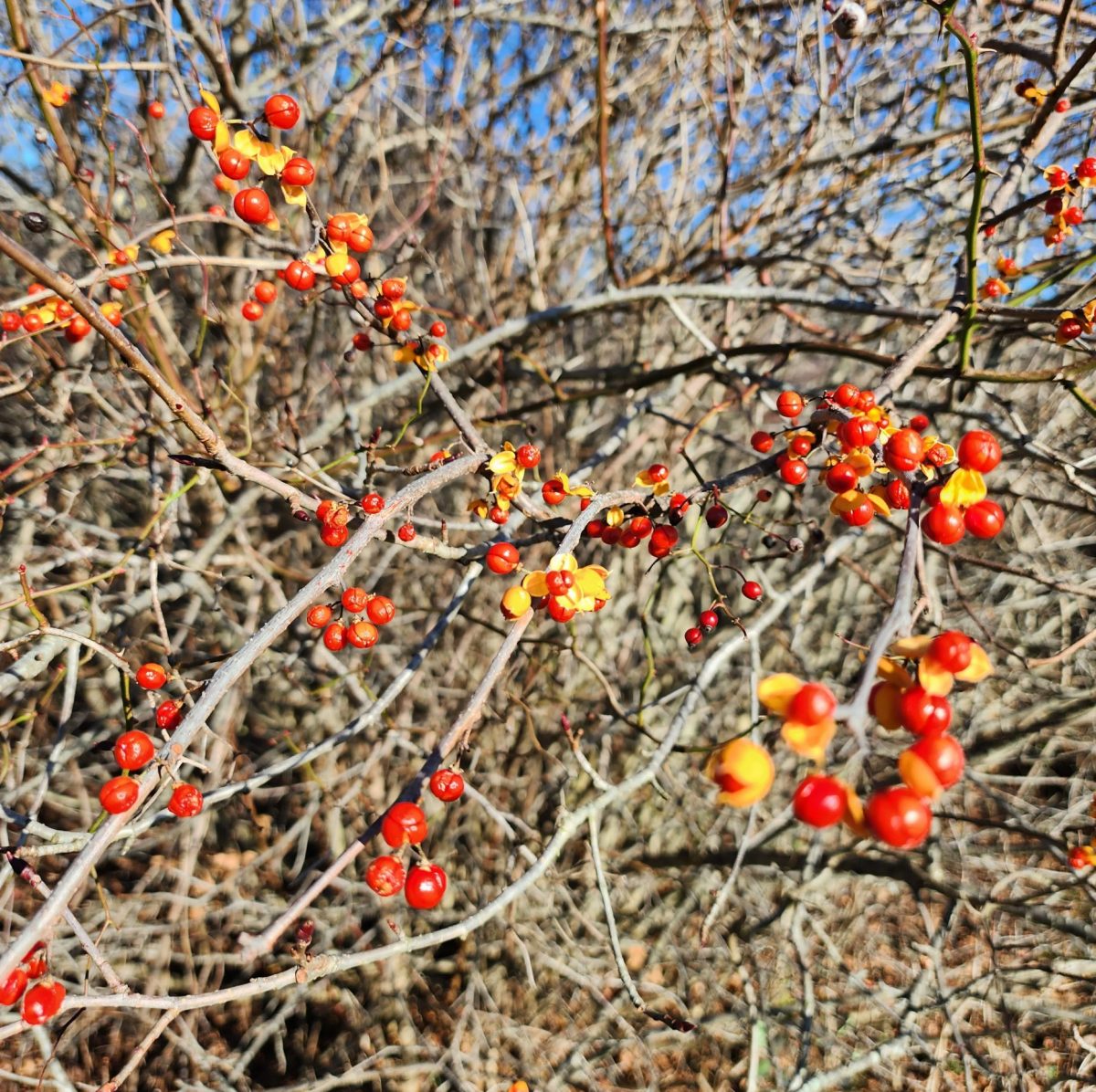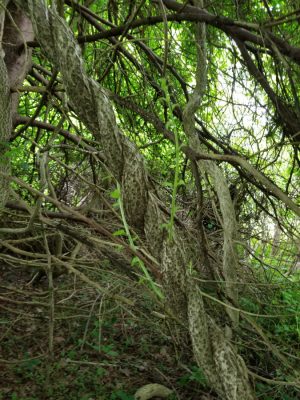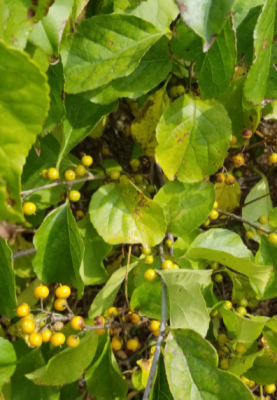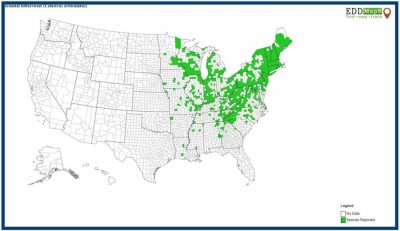Celastrus orbiculatus
By Victoria Wallace, Alyssa Siegel-Miles, and Klaudia Sowizral, UConn Extension
Identifying Features
- Overview: Deciduous woody vine that climbs, suffocates and strangles other plants. Vines can grow up to 60 ft tall and 4 in. in diameter. Also known as Oriental bittersweet.
- Leaves: Alternate, 1-4 in. long, elliptical to circular. Pointed or round tip, bluntly toothed margins, glossy (not hairy). Yellow in autumn.
- Stems: Green when young, maturing to tan. Climb for support, lack tendrils, and have obvious lenticels (raised pores). Bark is tannish and furrowed.
- Flowers: Small and greenish, blooms in May-June. Male and female flowers usually occur on separate plants. Flowers grow among the leaves at leaf axils (in contrast to native bitter-sweet's flowers/fruit, which are found only at twig tips).
- Seed/Fruit: Small, globose, with a green casing that matures to yellow; casing splits open to reveal red berry-like fruit. Fruit is poisonous to humans, but eaten and dispersed by birds. Fruit persists through winter.
- Roots: Orange roots that sucker aggressively, especially when the plant is cut at the soil line or pulled without removal of all roots.
- Reproduction: By seed. Also spreads vegetatively by spreading underground roots that form new stems.



Habitat
Asiatic bittersweet grows in a wide variety of habitats, including rocky slopes, grasslands, beaches, and flood plain forests. Although it thrives in full sun locations, seedlings are extremely shade-tolerant. It is most commonly found in open woodlands, abandoned fields, forest and woodland edges, and roadsides, where Asiatic bittersweet can outcompete other vegetation, twining around and strangling trees.
Control
MECHANICAL CONTROL:
- Seedlings/very young plants can be pulled or removed. Routine monitoring for seedling emergence is critical. Seedlings are easiest to remove when the soil is moist and the population is small. Pull steadily and slowly to minimize soil disturbance. Tamp down the soil after plants are removed.
- Bittersweet’s deep root system often makes pulling or torching impractical for any plant larger than a seedling. It is not recommended to pull established plants or cut them at the soil line, as this action stimulates the roots to resprout, forming new (clonal) plants and intensifying the infestation.
- Repeated cutting of bittersweet at 1-2 ft. above the soil line exhausts the plant’s energy reserves. Plants will resprout from the nodes below the cut rather than from the soil line. Cut at 2 ft for the first cut; subsequent cuts may be at 1 ft. Repeated cutting (at least 1-3x/year, for multiple years, depending on the size of the plant) at the 1-2 ft. line weakens the plant to the point that a small to medium sized plant may be easily pulled from the soil. This cutting process also reduces the vine’s ability to climb and wrap itself around trees and shrubs. Cut vines that are left hanging in the canopy will eventually deteriorate. Commitment and follow through are required to achieve control. Mechanical control may need to be combined with chemical controls for larger plants or larger populations.
CHEMICAL CONTROL:
Follow label direction when using all chemical treatments.
Glyphosate or triclopyr can be painted on cut stems in late summer or applied as foliar sprays. Glyphosate is most effective for cut surface treatment while plants are fully leafed and actively growing. When using anon-selective foliar spray, care must be taken to avoid injury to neighboring plants. Visit Michigan Dept. of Natural Resources for more details.
Disposal of Removed Plants:
Plant material with fruit present should be burned or bagged and disposed of in municipal waste. Plant parts without fruit should be placed in the sun to dry and may be put in a compost or mulch pile, provided that care is taken to ensure that all removed plant parts are dead and no fruit is present.

Distribution

Asiatic bittersweet is found mostly in the northeast regions of the U.S., including all the New England states. Outbreaks are found as far west as Minnesota and in some southern states.
Other Facts and Backgrounds
Asiatic bittersweet is native to Eastern Asia, including Japan, China, and Korea. It was originally introduced to the U.S. as an ornamental and for erosion control. In CT, its movement as well as its sale is prohibited. Do not buy or make wreaths of the fruit of these vines.
SOURCES:
- Connecticut Invasive Plants Council. (2018, October). Connecticut Invasive Plant List. cipwg.uconn.edu/wp-content/uploads/sites/244/2023/04/CT-Invasive-Plant-List-2018_Scientific-Name.pdf
- Dreyer, G. D. (1994). In J. M. Randall (Ed.): Element Stewardship Abstract For Celastrus orbiculata. The Nature Conservancy. invasive.org/gist/esadocs/documnts/celaorb.pdf
- Michigan Department of Natural Resources. (2012, February). Invasive Species - Best Control Practices: Oriental bittersweet. mnfi.anr.msu.edu/invasive-species/OrientalBittersweetBCP.pdf
- NH Department of Agriculture, Markets & Food, Division of Plant Industry. (n.d.). Oriental bittersweet. https://www.agriculture.nh.gov/publications-forms/documents/oriental-bittersweet.pdf
- Round leaf bittersweet: Celastrus orbiculatus Thunb. (n.d.). Invasive.org. Retrieved April 2021 from invasive.org/browse/subinfo.cfm?sub=3012
- Varricchio, E. & Connecticut Invasive Plant Working Group. (n.d.). Connecticut’s Invasive Plant Management Calendar: The Top 10 Invasive Plants [PowerPoint slides]. Connecticut Invasive Plant Working Group. cipwg.uconn.edu/wp-content/uploads/sites/244/2018/10/Invasive-Plant-Management-Calendar.pdf
View the pdf version of this document at Invasive Plant Factsheet: Asiatic Bittersweet, Celastrus orbiculatus.
Questions? Contact:
Vickie Wallace
UConn Extension
Extension Educator
Sustainable Turf and Landscape
Phone: (860) 885-2826
Email: victoria.wallace@uconn.edu
Web: ipm.uconn.edu/school
UConn Extension is committed to providing equal access and full participation for individuals with disabilities within all our programs and activities. Visit s.uconn.edu/accessibility for more resources. UConn is an equal opportunity program provider and employer.
©UConn Extension. All rights reserved.
Updated April 2021
  |